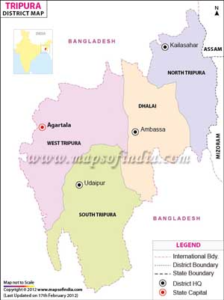In news– Tribal outfits in Tripura have been demanding to carve out a separate state of ‘Greater Tipraland’ for the indigenous communities in the region under Article 2 and 3 of the Constitution.
The demand for Greater Tipraland-
- Tripura was a kingdom ruled by the Manikya dynasty from the late 13th century until the signing of the Instrument of Accession with the Indian government on October 15, 1949.
- It has been pointed out that the indigenous people have been dislodged from land reserved for them by the penultimate king of the Manikya dynasty Bir Bikram Kishore Debbarman.
- The demand mainly stems from the anxiety of the indigenous communities in connection with the change in the demographics of the state, which has reduced them to a minority.
- It happened due to the displacement of Bengalis from the erstwhile East Pakistan between 1947 and 1971.
- From 63.77 per cent in 1881, the population of the tribals in Tripura was down to 31.80 per cent by 2011.
- Among the 19 notified Scheduled Tribes in Tripura, Tripuris (aka Tipra and Tiprasas) are the largest.
- According to the 2011 census, there are at least 5.92 lakh Tripuris in the state, followed by Reangs (1.88 lakh) and Jamatias (83,000).
- Tripuris demand the Tripura Tribal Areas Autonomous District Council and some surrounding areas to be made into a separate state from Tripura by name Tipraland.
- There is also a demand for a Greater Tipraland by adding Tripuris dominant areas outside the Tripura- Mamit district of Mizoram, Cachar and Hailakandi districts in Assam, and Bandarban, Khagrachari, and Chittagong of Bangladesh.

Steps taken to address their demand-
- The Tripura Tribal Areas Autonomous District Council (TTAADC) was formed under the sixth schedule of the Constitution in 1985 to ensure development and secure the rights and cultural heritage of the tribal communities.
- The TTAADC, which has legislative and executive powers, covers nearly two-third of the state’s geographical area.
- The council comprises 30 members of which 28 are elected while two are nominated by the Governor.
- Also, out of the 60 Assembly seats in the state, 20 are reserved for Scheduled Tribes.
Article 2 and 3 of the Constitution-
- Article 2 of the Constitution deals with admission or establishment of new states. It states that Parliament may by law admit into the Union, or establish, new States on such terms and conditions, as it thinks fit.
- Article 3 comes into play in the case of formation of new States and alteration of areas, boundaries or names of existing States by the Parliament.
















